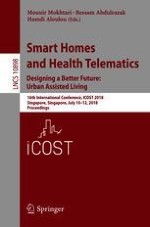2018 | Buch
Smart Homes and Health Telematics, Designing a Better Future: Urban Assisted Living
16th International Conference, ICOST 2018, Singapore, Singapore, July 10-12, 2018, Proceedings
herausgegeben von: Mounir Mokhtari, Bessam Abdulrazak, Hamdi Aloulou
Verlag: Springer International Publishing
Buchreihe : Lecture Notes in Computer Science
